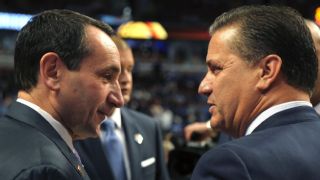|
One of the most peculiar aspects of college basketball also happens to be one of its most prominent features. Duke and Kentucky are programs everyone talks about, and teams that, almost without exception, recruit better than any other "brands" nationally. Yet, to a certain extent, the Blue Devils and the Wildcats appear to be trapped under a one-and-done ceiling on performance. Past national champions such as Duke in 2014-15 and Kentucky in 2011-12 were great not only because of their one-and-done stars but also because of their veterans. Veterans are increasingly hard to find on recent rosters led by Mike Krzyzewski and John Calipari. In the one-and-done era, no team has ever earned a No. 1 seed in the NCAA tournament with a roster that returned fewer than 30 percent of its possession minutes from the previous season. Duke has now come in under that 30 percent threshold in two of the last three seasons. Kentucky has done so every year since its undefeated run to the 2015 Final Four. Looking ahead toward next season, it appears that the Blue Devils, at least, will once again rely heavily on freshmen. Of course, when the freshmen in question are players like R.J. Barrett, Zion Williamson and Cam Reddish, that reliance could very well turn out to be a good thing. Talent will again be abundant next season in Durham, North Carolina.  It will, however, be young talent. Grayson Allen has come to the end of his eligibility, and Marvin Bagley III, Gary Trent Jr. and Trevon Duval have all declared for the NBA draft and hired agents. Even if Wendell Carter Jr. were to decide to return for his sophomore season (which is no sure thing), the players who have already departed mean Duke would return just 30 percent of its possession minutes next season. Kentucky's situation is, for the moment, a little more uncertain. Kevin Knox is the only Wildcat who has both declared for the draft and hired an agent. PJ Washington has also declared for the draft but has not hired an agent. It's only mid-April, however, and it's possible that more of Calipari's players will announce their intentions to leave school early. Recent history suggests that the stakes are higher than we might think for the Wildcats with regard to these upcoming go-or-stay decisions. Indeed, the correlation between returning experience and statistical performance is even stronger for UK over the past nine seasons than it has been for Duke. To be sure, Kentucky is hardly chopped liver even when it puts a very young team on the floor. In fact, you can make a case that the 2016-17 group led by freshmen Malik Monk, De'Aaron Fox and Bam Adebayo was the best very young team of the bunch. That team returned just 26 percent of its possession minutes from the previous season, yet UK came within a Luke Maye game winner of going to overtime against North Carolina with a trip to the Final Four on the line. Most teams would take that kind of performance in a heartbeat. Very young Duke and Kentucky teams can, of course, still be very good. But the best teams that these programs have produced over the last decade have, without exception, been older. Whether your preferred example is the Kentucky team that won the 2012 national title (while returning 53 percent of its possession minutes from the previous season), the Duke team that won it all in the 2015 tournament (42 percent) or even the UK team that came up just short that same season (60), these were all rosters that were more experienced than what we've seen from the two programs over the last three seasons. It raises the possibility of whether success at recruiting one-and-done-track talent might be too much of a good thing. The very trait that defines Duke and Kentucky -- the ability to land the best talent -- is turning out to be imperfectly correlated to the ultimate objective, putting the best team on the floor. Then again, maybe Duke and Kentucky can have the best of both worlds. It only takes a small number of multiseason types like, say, Luke Kennard or Tyler Ulis to have a large impact on a roster. The needle to be threaded is simply finding -- and, most crucially, allotting space for -- nascent college stars who can nevertheless elude the NBA's grasp after their freshman season. It comes down to a challenge of talent sequencing, and, as long as NBA eligibility rules remain the way they are, the task to be accomplished will also remain the same. The challenge is this: It's feasible for a Duke or a Kentucky to put a team on the floor every season that is (almost) entirely made up of one-and-done talent. However, teams fitting that profile tend to be ranked higher in November (Kentucky has been ranked in the top five nationally in the last seven consecutive preseasons) than in April. When these two talent-rich programs get their arms around this challenge of talent sequencing, then we'll really see something. Both programs answered the challenge successfully, by accident or design, in 2014-15. Chances are they will do it again soon.
|

